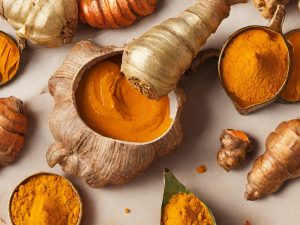A Yellow Solution for a Yellow Problem
Here’s a fun twist: to address that troubling yellow discoloration on your toenails, turn to another shade of yellow. Yes, I’m talking about turmeric, the golden-hued spice that has been a staple in Asian cuisines and traditional medicine for centuries.
Why Turmeric? Here’s My Take
Turmeric isn’t just a key ingredient for adding flavor to curries. This vibrant yellow spice has a long history in natural medicine, especially in Ayurvedic practices. Over time, it’s been used to tackle inflammation, pain, and even skin issues. But how does this relate to nail fungus, you ask?
Well, turmeric contains a compound called curcumin. This powerhouse component doesn’t just give turmeric its vibrant color. It’s also a potent antimicrobial agent. This means it can potentially wage war against various microscopic invaders, including the fungi responsible for that unsightly toenail condition.

Toe-to-Toe with Toenail Fungus
Toenail fungus, or what we’ll refer to as “that stubborn yellow menace,” doesn’t just pop up overnight. It takes hold slowly, often due to prolonged exposure to moisture or minor injuries that open the door to fungal invaders. And when it does strike, it’s not just about appearances. It can be painful and, if left untreated, could lead to more severe complications.
How Turmeric Fights Back
Here’s the deal: turmeric’s curcumin content has some impressive antifungal properties. Some studies suggest that it can inhibit the growth of various fungi strains, including those responsible for toenail infections. Now, let’s be clear. It might not be a magic bullet, but it’s a natural remedy worth considering.
Rolling Up Your Sleeves: Let’s Get Started
The Simple Turmeric Paste
- Ingredients:
- Fresh turmeric root (or turmeric powder if the root is unavailable)
- A small amount of water
- Directions:
- Grind the turmeric root to get a smooth paste. If you’re using powder, mix it with water to get the right consistency.
- Apply this paste to the affected nail.
- Let it sit for about 30 minutes.
- Wash it off with lukewarm water and pat dry.
- Repeat daily.
Note: Turmeric is notorious for staining, so use gloves or be prepared for temporarily yellow fingers!
Turmeric Oil Soak
- Ingredients:
- Turmeric essential oil (yes, it exists!)
- A basin of warm water
- Directions:
- Fill a basin with warm water.
- Add a few drops of turmeric essential oil.
- Soak your feet for about 20 minutes.
- Pat them dry with a clean towel.
- Do this every alternate day.
Remember: If you feel any burning or irritation, stop immediately. Everyone’s skin reacts differently, so always listen to your body.
What About Turmeric Supplements?
It’s a hot topic! Some believe taking turmeric or curcumin supplements can have systemic antifungal benefits. There’s some truth to it, especially given the broader health benefits of curcumin. But for direct toenail fungus issues, topical application seems to be the way to go. However, if you’re considering supplements, always consult with a healthcare professional first. Safety first, always
| Compound Name | Short Description | References |
|---|---|---|
| Curcumin | Exhibits antibacterial, antiviral, and antifungal activity | [1][3][4][5] |
| Turmeric Essential Oil | Possesses antimicrobial and antifungal properties | [2] |
| Ar-Turmerone | Exhibits antibacterial and antifungal activity | [1][4] |
| Turmerone | Possesses antibacterial and antifungal properties | [1][4] |
| Bisacurone | Exhibits antibacterial and antifungal activity | [1][4] |
| Cyclocurcumin | Possesses antibacterial and antifungal properties | [1][4] |
| Demethoxycurcumin | Exhibits antibacterial and antifungal activity | [1][4] |
| Tetrahydrocurcumin | Possesses antibacterial and antifungal properties | [1][4] |
| Turmerin | Exhibits antibacterial and antifungal activity | [1][4] |
| Turmerosaccharides | Possesses antibacterial and antifungal properties | [1][4] |
References:
[2] ScienceDirect Article (S095671351630531X)
[3] MDPI Article (1424-8247/13/7/153)
[4] MDPI Article (1422-0067/22/13/7130)





Leave a Reply